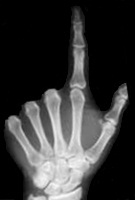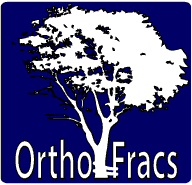Journal Club
January 2011
Knee Summary - Australian Joint Registry 2010
Reviewed by
Dr Andrew Mattin
MBBS | Senior Accredited Orthopaedic Registrar
- September 1999 - December 2009.
- 289,274 Knee replacements up to 31 Dec 2009.
- Up 40,675 from last year
- Partial 11.7%
- Primary total 80%
- Revisions 8.4%
- 2/3 in Private sector.
- (68.8% in 2009)
- (68.8% in 2009)
Primary partial knee replacements
- Types of partial knee replacements
- Unicompartment knee 94.6%
- Patellotrochlear 4.5%
- Partial resurfacing 134,
- 74% < 55 yo.
- One cap implants (revision 17.9% at 3 years)
- Reasons for revision
- Progression of disease
- loosening
- pain
- Cumulative Percentage revision
- Unicompartment KR
- 2.2% at 1 year
- 13.4% at 9 years.
- Unispacers. n=40.
- All revised after 1 year
- Bicompartmental. n=126.
- 6.4% revised 1 year due to patellofemoral pain.
- 6.4% revised 1 year due to patellofemoral pain.
- Patella/trochlear. n=1,519.
- 75.4% females.
- 1 year revision 22.4%.
- Causes
- Progression of disease,
- loosening.
- Young males had high rates of
revision.
- Unicompartment KR
Unicompartmental. n=31,884
- up 3,062 from last year however declining in proportion to TKR.
- Equal gender distribution.
- Age 55-74.
- Components
- Oxford3,
- ZUK,
- Unix.
- Cumulative revision at 9 years 13.3%
- Loosening/lysis 49.9%,
- disease progression 19.6%,
- pain 12.0%.
- Increased risk in young, females
Primary TKR
- Femorotibial articulation +/- patellar replacement.
- 231,409, up 34,108 from last report.
- 83.9% of all knee replacement procedures.
- OA 97.1%
- Females 57.3%
- Age 55-64. 27.3%
- Increasing use in younger patients.
- Increasing use in younger patients.
- Majority of replacements are undertaken without resurfacing the patellar
- Most popular prosthesis
- based on femoral component.
- Triathalon 13.8%,
- PFC Sigma 11.4%,
- LCS 11.0%.
- Combined
- Nexgen 19.7% (LPS, LPS Flex, LCCK)
- Nexgen 19.7% (LPS, LPS Flex, LCCK)
- based on femoral component.
- 9 year revision rate 5.1%
- Loosening/ lysis 31.3%,
- infection 22.2%,
- Patellofemoral pain 14.3%,
- pain 9.1%,
- instability 5.5%.
- Infection dominates revision within first year. (1.3% at 9 years.)
- Components revised
- Tibial and femoral revision 23.3%,
- patella only replacement 22.0%,
- insert only exchange 20.5%
- Dx.
- OA,
- RA
- RA has the lowest rate of revision.
- other inflammatory arthritis,
- AVN.
- Age.
- Younger the higher the revision rate.
- <55yo four times the rate than a 75yo at 3 years.
- Gender
- Males higher risk of revision.
- Males higher risk of revision.
- Outcome by prosthesis characteristics
- Fixed and mobile bearing.
- Fixed bearing have a lower rate of revision compared to mobile bearing.
- Fixed bearing have a lower rate of revision compared to mobile bearing.
- All-polyethylene tibial prostheses
- higher risk of revision to moulded non modular and fixed modular tibial prosthesis
- Fixed and mobile bearing.
- Stability
- Posterior stabilised significantly higher risk of revision compared to minimally stabilised.
- Posterior stabilised significantly higher risk of revision compared to minimally stabilised.
- Patellar resurfacing
- Resurfacing patella is associated with lower risk of revision in first nine years.
- Risk of revision varies between minimally and posterior stabilised prosthesis.
- Posterior stabilised without patella resurfacing has highest risk of revision (829 revised out of 22,463).
- Resurfacing patella is associated with lower risk of revision in first nine years.
- Fixation
- There is no difference between cemented and hybrid fixation.
- Risk of revision in first year is less in cemented and hybrid than cementless.
- After that year the risk is less for uncemented. (After bony ingrowth.)
- There is no difference between cemented and hybrid fixation.
- Prosthesis types.
- 320 femoral and tibial prosthesis combinations in the registry.
- Cemented.
- Nexgen CR/Nexgen has the lowest cumulative percentage revision at 9 years of 2.9%.
- Nexgen CR/Nexgen has the lowest cumulative percentage revision at 9 years of 2.9%.
- Uncemented.
- Advantim/Advantim has lowest at 1.5%
- Advantim/Advantim has lowest at 1.5%
- Hybrid.
- AGC/AGC 2.7%
- AGC/AGC 2.7%
- LCS Duofix femoral prosthesis recalled in 2009 had highest revision rate.
- 320 femoral and tibial prosthesis combinations in the registry.
- Demographic
- 24,162 revisions registered. Up 3,200.
- Type.
- Major 67.4%
- Most common major was tibial/ femoral (48.3%) tibia only (8.2%).
- Most common major was tibial/ femoral (48.3%) tibia only (8.2%).
- Minor 32.6%
- Insert only 13.4%,
- patellar only 10.3%
- insert and patella 7.3%
- No change in proportion of major, minor, partial since 2003.
- Major 67.4%
- 24,162 revisions registered. Up 3,200.
- Age.
- Most revisions in 65-74 yo.
- More common in females.
- Most revisions in 65-74 yo.
- Aetiology
- Loosening/lysis most common 42.2%
- Loosening/lysis most common 42.2%
- Outcomes of first revision in primary unicompartmental knee replacement.
- 2,291. (Infections excluded)
- Lowest risk of re-revision for a revised unicompartmental knee is when it is revised to TKR. (9.8%.)
- Revision to another unicomp fails in 30% at 3 years.
- Uni to uni was most common for insert exchange or major partial revisions of femoral or tibial components.
- Revision rate for uni to total is equivalent to total to total.
- 2,291. (Infections excluded)
- Outcome of first revision of primary total knee replacement.
- 4,946 (Infections excluded)
- Minor revisions have a similar risk to major partial or major total revisions.
- Femoral only revision has a higher risk of re-revision than tibial/ femoral revision.
- Revising the patella has same risk of re-revision as a major revision.
- 4,946 (Infections excluded)
Prothesis highlighted in Registry with poor results
- Newly identified
- Genesis II/ Genesis II CR Cementless
- Revision rates 11.0% at 3 years.
- Two and a half times revision rate compared to all others. (loosening and lysis)
- Opetrak CR
- 8.1% revision rate. (Patellofemoral pain, Loosening/lysis)
- 8.1% revision rate. (Patellofemoral pain, Loosening/lysis)
- Genesis II/ Genesis II CR Cementless
Take home message
- Primary
- TKR include patellar
- Cemented or hybrid
- Fixed bearing, minimally stabilised
- TKR include patellar
- Revisions
- Revise all components in revision surgery.
Webpage Last Modified:
20 February, 2011



